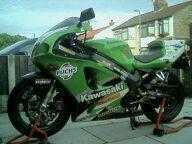Kawasaki Ninja ZX-7R

The Kawasaki ZX-7R was a sport bike made by Kawasaki from 1996 to 2003. It replaced the more race-oriented ZXR-750 in the 750cc supersports class. It remained largely unchanged through its production.
Between 1990 and 1995 in the US market the ZXR-750 and ZXR-750R were known as ZX-7 and ZX-7R respectively. Starting from 1996 Kawasaki dropped the ZXR name adopting the ZX-7R worldwide.
Overview
The ZX-7R was raced, gaining 12 AMA superbike championship victories. Kawasaki's Road Racing team riders were Eric Bostrom, Doug Chandler and Scott Russell.
The ZX-7R has a 749 cc in-line four-cylinder, four-stroke engine.
The frame used on the ZX-7R is a lightweight aluminum twin-spar item, designed using computer-aided design to optimize strength. The rear subframe was constructed using steel and aluminum, providing enough strength for a pillion passenger whilst keeping weight to a minimum.
The swingarm used largely the same fabrication techniques to produce a hollow cast and pressed aluminum alloy hybrid swingarm, and the Uni-Trak rear suspension system features a predominantly lightweight alloy and aluminum construction. The Uni-Trak system was designed to provide a progressively stiffer damping and spring rate under compression. The rear suspension unit is fully adjustable in terms of damping, preload and compression.
The front suspension found on the ZX-7R comprises a fully adjustable 43 mm inverted cartridge fork.
Front brakes are 320 mm semi-floating front discs and Tokico six-piston calipers. Rear brakes feature a 230 mm disc with a twin-piston opposed caliper.
The ZX-7RR differs from the road model with an adjustable head-stock angle, swing arm pivot, additional increased adjustability to the front and rear suspension, a solo cowl with a slightly different subframe, and 41 mm flat-slide carburetors. It also has a close ratio gear-box fitted as standard and Nissin front calipers.
References
| « previous - Kawasaki motorcycle timeline, 1990–present | ||||||||||||||||||||||||||
|---|---|---|---|---|---|---|---|---|---|---|---|---|---|---|---|---|---|---|---|---|---|---|---|---|---|---|
| Year → Type ↓ |
1990s | 2000s | 2010s | |||||||||||||||||||||||
| 0 | 1 | 2 | 3 | 4 | 5 | 6 | 7 | 8 | 9 | 0 | 1 | 2 | 3 | 4 | 5 | 6 | 7 | 8 | 9 | 0 | 1 | 2 | 3 | 4 | 5 | |
| Standard | W650 | W800 | ||||||||||||||||||||||||
| KLE500 | Versys | |||||||||||||||||||||||||
| ER-5 | ER-6n/ER-6f/Ninja 650R | |||||||||||||||||||||||||
| ZR750 Zephyr | ZR-7 | Z750 | Z800 | |||||||||||||||||||||||
| Zephyr 400/550/1100 | Z1000 | |||||||||||||||||||||||||
| ZRX1100 | ZRX1200R | |||||||||||||||||||||||||
| Dual-sport | KL250 Super Sherpa | |||||||||||||||||||||||||
| KLR250 | KLX250S | |||||||||||||||||||||||||
| KLR650 | ||||||||||||||||||||||||||
| Sport | Ninja 250R | |||||||||||||||||||||||||
| Ninja 400 | Ninja 300 | |||||||||||||||||||||||||
| Ninja ZX-2R/Ninja ZXR250 | ||||||||||||||||||||||||||
| ZXR400 | ||||||||||||||||||||||||||
| EX500/GPZ500/Ninja 500 | ||||||||||||||||||||||||||
| ZX600C-E/Ninja ZX-6 | ZX600J/Ninja ZX-6R | |||||||||||||||||||||||||
| ZZR600 | ||||||||||||||||||||||||||
| ZXR750 | Ninja ZX-7R | |||||||||||||||||||||||||
| GPZ900R | Ninja 1000 | |||||||||||||||||||||||||
| ZX900/Ninja ZX-9R | Ninja ZX-10R | |||||||||||||||||||||||||
| Ninja H2 / H2R | ||||||||||||||||||||||||||
| ZX-10 Tomcat | ZX12R/Ninja ZX-12R | |||||||||||||||||||||||||
| Sport-Touring | GPZ1100/ZX1100E | |||||||||||||||||||||||||
| ZZR1100C/Ninja ZX-11C | ZZR1100D/Ninja ZX-11D | ZZR1200/ZX-12C | ZZR1400/Ninja ZX-14 | |||||||||||||||||||||||
| Touring | GTR1000/Concours | 1400GTR/Concours 14 | ||||||||||||||||||||||||
| Cruiser | EL250 | EL125/Eliminator | ||||||||||||||||||||||||
| 454 LTD | Vulcan VN500C | |||||||||||||||||||||||||
| Vulcan EN500A | ||||||||||||||||||||||||||
| Vulcan S | ||||||||||||||||||||||||||
| Vulcan VN750 | ||||||||||||||||||||||||||
| Vulcan VN800A/Vulcan Classic VN800B | Vulcan VN900 Classic/VN900B | |||||||||||||||||||||||||
| Vulcan 800/1500 Drifter | ||||||||||||||||||||||||||
| Vulcan VN1500 | ||||||||||||||||||||||||||
| Vulcan VN1600 | Vulcan VN1700 | |||||||||||||||||||||||||
| Vulcan VN2000 | ||||||||||||||||||||||||||
| MotoGP | Ninja ZX-RR | |||||||||||||||||||||||||